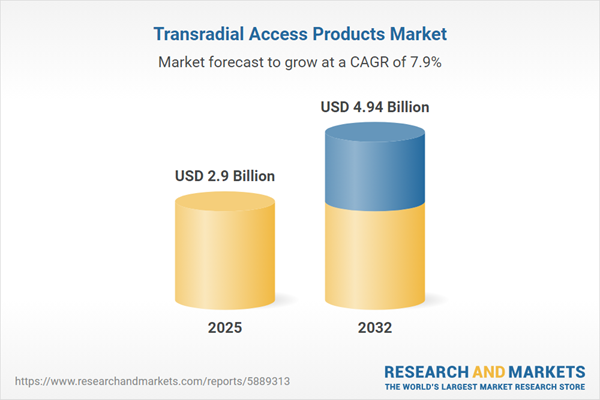Speak directly to the analyst to clarify any post sales queries you may have.
The Transradial Access Products Market is experiencing notable momentum as healthcare systems prioritize minimally invasive cardiovascular interventions. Senior decision-makers seeking data-driven insights will find this report indispensable in understanding current dynamics, technology adoption, and global strategic opportunities shaping the sector.
Market Snapshot: Transradial Access Products Market
The transradial access products market grew from USD 2.68 billion in 2024 to USD 2.90 billion in 2025. With strong demand for reliable radial artery devices, the sector is forecast to grow at a CAGR of 7.90%, reaching USD 4.94 billion by 2032. Key market forces include a robust shift toward minimally invasive cardiovascular procedures, innovation in device design, and strategic responses to evolving regulatory and procurement landscapes.
Scope & Segmentation
- Product Types: Diagnostic Catheters, Guiding Catheters, Introducer Needles, Sheaths (4f, 5f, 6f)
- Procedure Types: Diagnostic Coronary Angiography, Percutaneous Coronary Interventions
- End Users: Ambulatory Surgical Centers, Cardiac Catheterization Laboratories, Hospitals
- Sheath Sizes: 4f, 5f, 6f
- Coating Types: Hydrophilic Coating, PTFE Coating
- Distribution Channels: Direct Sales, Distributor Network, Online Sales
- Geographic Coverage: Americas (United States, Canada, Mexico, Brazil, Argentina, Chile, Colombia, Peru), Europe (United Kingdom, Germany, France, Russia, Italy, Spain, Netherlands, Sweden, Poland, Switzerland), Middle East (United Arab Emirates, Saudi Arabia, Qatar, Turkey, Israel), Africa (South Africa, Nigeria, Egypt, Kenya), Asia-Pacific (China, India, Japan, Australia, South Korea, Indonesia, Thailand, Malaysia, Singapore, Taiwan)
- Key Players: Abbott Laboratories, Boston Scientific Corporation, Terumo Corporation, Medtronic plc, Cardinal Health, Inc., B. Braun Melsungen AG, Merit Medical Systems, Inc., Asahi Intecc Co., Ltd., Teleflex Incorporated, Smiths Group plc
Key Takeaways
- The adoption of transradial access technology supports improved patient comfort and streamlined recovery in cardiovascular interventions, aligning with the priorities of modern healthcare systems.
- Manufacturers are collaborating with clinical leaders to expand portfolios, introducing products optimized for specific vessel characteristics and procedural needs, including innovative coatings and ergonomic sheath designs.
- Healthcare providers across regions are integrating transradial protocols to reduce complication rates and optimize resource use, with differentiated uptake in North America, Europe, the Middle East, Africa, and Asia-Pacific.
- Product differentiation is driven by advances in hydrophilic and PTFE coatings, miniaturization, and device compatibility, all crucial for clinicians managing varied vessel anatomies and procedural complexities.
- Strategic commercial approaches, including direct and distributor sales as well as online platforms, are increasingly important for reaching target markets and ensuring product availability in high-volume centers.
Tariff Impact: Navigating U.S. Tariff Regulations and Supply Chain Resilience
Recent U.S. tariff regulation changes have notably affected supply chains for transradial access products. Device manufacturers are diversifying production locations and forging new partnerships with domestic manufacturers to address increased import duties and ensure continuity of supply. Distributors and hospital procurement teams are employing dynamic sourcing and inventory strategies to safeguard device availability amid regulatory change.
Methodology & Data Sources
This report synthesizes primary insights from structured interviews with clinicians and procurement experts, as well as secondary research from clinical registries, regulatory documents, and industry white papers. Triangulation and rigorous peer review underpin the accuracy of the analysis, ensuring actionable and reliable intelligence for stakeholders.
Why This Report Matters
- Enables strategic procurement planning through detailed segmentation and analysis of technology adoption, product differentiation, and regional market nuances.
- Provides senior leaders with context on regulatory impacts and actionable recommendations for building agile, risk-resilient supply chains in a rapidly changing landscape.
- Supports competitive positioning through evidence-based insights on innovation, channel strategy, and clinician partnership models.
Conclusion
The transradial access products market is dynamic, shaped by clinical advancements, regulatory influences, and shifting procurement strategies. Stakeholders prepared to leverage emerging trends and data-driven insights will optimize outcomes and strengthen their position in this evolving sector.
Additional Product Information:
- Purchase of this report includes 1 year online access with quarterly updates.
- This report can be updated on request. Please contact our Customer Experience team using the Ask a Question widget on our website.
Table of Contents
3. Executive Summary
4. Market Overview
7. Cumulative Impact of Artificial Intelligence 2025
Companies Mentioned
The companies profiled in this Transradial Access Products market report include:- Abbott Laboratories
- Boston Scientific Corporation
- Terumo Corporation
- Medtronic plc
- Cardinal Health, Inc.
- B. Braun Melsungen AG
- Merit Medical Systems, Inc.
- Asahi Intecc Co., Ltd.
- Teleflex Incorporated
- Smiths Group plc
Table Information
| Report Attribute | Details |
|---|---|
| No. of Pages | 192 |
| Published | November 2025 |
| Forecast Period | 2025 - 2032 |
| Estimated Market Value ( USD | $ 2.9 Billion |
| Forecasted Market Value ( USD | $ 4.94 Billion |
| Compound Annual Growth Rate | 7.9% |
| Regions Covered | Global |
| No. of Companies Mentioned | 11 |









